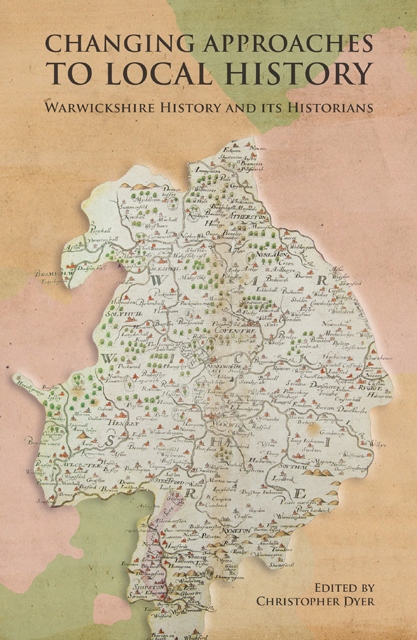Book contents
- Frontmatter
- Contents
- List of Illustrations
- Notes on Contributors
- Foreword
- Acknowledgements
- List of Abbreviations
- Introduction
- 1 The Dugdale Society: Its First Hundred Years
- 2 The Beginnings of Coventry
- 3 Was Commerce in Late Medieval Coventry Restricted by Regulation?
- 4 Studying Late Medieval Small Towns in Warwickshire 1920–2020
- 5 Rural Warwickshire in the Middle Ages: Society and Landscape
- 6 Religion, Rebellion and Red Jackets: Changing Approaches to Society and Politics in Sixteenth-century Warwickshire
- 7 Social Networks, Intellectual Affinities and Communal Harmony in Post-Reformation Warwickshire
- 8 Discovering Warwickshire’s Vernacular Architecture
- 9 Local History and the English Civil War: A View from Warwickshire
- 10 Writing Histories of the Landed Elite in Georgian Warwickshire
- 11 The Victoria County History in Warwickshire
- 12 Writing Women into the Political History of Warwickshire
- 13 Shakespeare and the Warwickshire Landscape in the Age of the Tourist
- Conclusion
- Index
8 - Discovering Warwickshire’s Vernacular Architecture
Published online by Cambridge University Press: 17 December 2022
- Frontmatter
- Contents
- List of Illustrations
- Notes on Contributors
- Foreword
- Acknowledgements
- List of Abbreviations
- Introduction
- 1 The Dugdale Society: Its First Hundred Years
- 2 The Beginnings of Coventry
- 3 Was Commerce in Late Medieval Coventry Restricted by Regulation?
- 4 Studying Late Medieval Small Towns in Warwickshire 1920–2020
- 5 Rural Warwickshire in the Middle Ages: Society and Landscape
- 6 Religion, Rebellion and Red Jackets: Changing Approaches to Society and Politics in Sixteenth-century Warwickshire
- 7 Social Networks, Intellectual Affinities and Communal Harmony in Post-Reformation Warwickshire
- 8 Discovering Warwickshire’s Vernacular Architecture
- 9 Local History and the English Civil War: A View from Warwickshire
- 10 Writing Histories of the Landed Elite in Georgian Warwickshire
- 11 The Victoria County History in Warwickshire
- 12 Writing Women into the Political History of Warwickshire
- 13 Shakespeare and the Warwickshire Landscape in the Age of the Tourist
- Conclusion
- Index
Summary
Warwickshire has been noted since the nineteenth century for its ‘chocolate box’ cottages, but it is only in the last half-century or so that we have begun to understand their history, their character as archaeo-logical objects and their significance for the people who built and occupied them. It is this developing recognition of such smaller historic buildings as ‘vernacular architecture’ that this chapter explores. The name itself has come to prominence only since the founding of the Vernacular Architecture Group in 1954; indeed, during the discussions preceding this, the alternative of Domestic Architecture Group was considered, so the name chosen was not entirely obvious. Surprisingly, though, the first usage of the term recorded by the Oxford English Dictionary (OED) was a century earlier, in 1857, when Sir George Gilbert Scott commented, ‘I want to call attention to the meanness of our vernacular architecture’, clearly referring, as the Dictionary defines it, to ‘architecture concerned with ordinary domestic and functional buildings rather than the essen-tially monumental’. The OED definition misses one important aspect of the subject, captured in the title of an influential book by Rudofsky, Architecture without Architects: the idea that vernacular buildings have architectural quality, but are designed by craftsmen following traditional practices rather than by architects following abstract ideas.
Before the 1950s, smaller traditional buildings were occasionally examined, usually for their physical structure and decoration. The earliest national studies were probably those of the Sheffield antiquaries, S. O. Addy and C. F. Innocent in the early 1900s, but relatively little else appeared in print, apart from a few journal articles, until after 1945. The growth of interest in vernacular architecture became apparent with the formation of the Vernacular Architecture Group (VAG) in 1954, bringing together people from a variety of disciplines, academics, students, museum curators, extra-mural tutors and, particularly, architectural recorders working for the Royal Commission on Historical Monuments (in England) and its equivalent in Wales.
Behind this developing enthusiasm were wider changes, mirroring new views on archaeology and society, turning from the elite to ordinary people and their lives. Many of the leaders of the VAG held left-wing views, which undoubtedly stimulated their engagement with everyday homes and environments, although this ideological underpinning has become less significant as understanding has increased.
- Type
- Chapter
- Information
- Publisher: Boydell & BrewerPrint publication year: 2022

